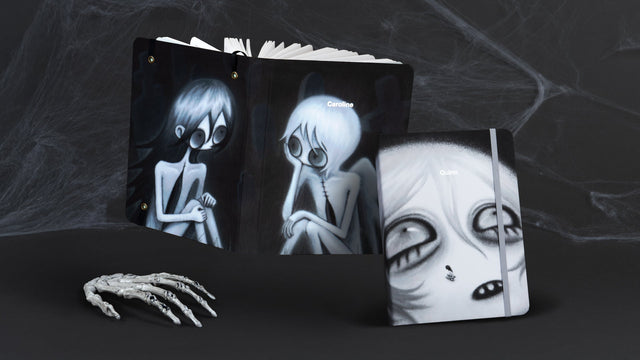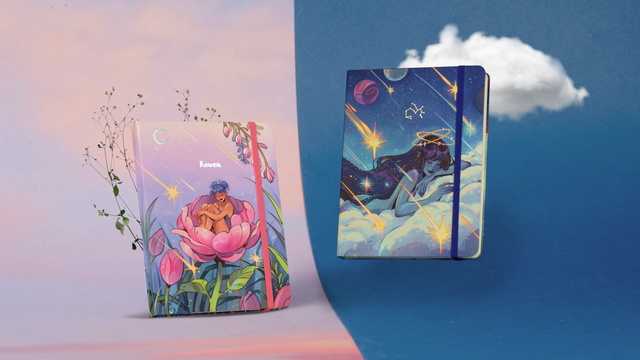For this year’s season of giving, we sat down with our talented friends from LIE Design Studio and convinced them to help us design a limited edition gift box! (We bribed them with cookies) Not only did they create the gift box, but they went above and beyond by also creating the Mosslets — 3 quirky little characters who are eager to follow you home and decorate your space.
Today, we speak to Driv about the eccentrically-named design studio he founded, as well as Yee Hsean (a.k.a. Sam), whose brainchildren are the Mosslets. Read more to dive deeper into the process.
Hi Driv and Sam, thank you for joining us today. First off, could you tell us a little bit about yourself?
Sam: Hi, I’m Sam. I’m a graphic designer at LIE Design Studio. I started interning with LIE when I was still studying, but before that, I had already known about them because one of my lecturers introduced their works to me, and I really liked a lot of their projects as they aligned with my own interests. After my graduation, Driv offered me to freelance with them, and I thought, sure, why not? Today, I’m more or less a permanent fixture in the studio. I’m there everyday! (laughs)
Driv: Hi, I’m Driv. I’m also a graphic designer, and I founded LIE in 2011. It’s an independent graphic design studio based in Kuala Lumpur. Personally, I like to work on projects that revolve around print design and visual identity, but as a studio, we work across a diverse range of visual communication projects, from brand identity to music albums. Constantly practicing and seeking fresh approaches everyday, we aim to provide innovative and beautiful solutions for our clients, as well as for our self-initiated projects.

Let’s talk about the Mossery Gift Box you designed for us this year. What do you think was the most interesting part of the project?
S: I personally enjoyed designing the Mosslets the most, since they were loosely based on the actual Mossery team. It was fun to try and translate their personalities into the little abstract creatures. The Mosslets have also gone through several changes in both their designs and personalities, some of which I grew quite attached to, simply because they looked absolutely ridiculous haha!

Early design stages of the Mosslets
Could you tell us about your inspirations behind the Mossery Gift Box and the Mosslets?
D: The shapes and patterns found on Christmas ornaments and baubles were a great source of inspiration for us. If you look closely, you’ll notice that we also had the Mosslets’ forms reappear on the gift box as if it’s about to come alive and transform into the characters themselves!

What were some of the challenges you encountered in this project?
S: It would definitely be figuring out the mechanisms of the Mosslets. It took up a large part of the design process, and we ran into even more issues during the production stage. I’m just glad things worked out, also thanks in no small part of the Mossery team’s efforts and support.
What do you hope that our customers will feel upon receiving this special Gift Box?
S: Anticipation! Excitement! Just like a kid rushing to open their presents on Christmas morning (:
LIE Design Studio / Little Ideas Everyday
What is the story behind the founding of LIE design studio?
D: Initially, I was working overseas., But after a few years, I decided to come back and pursue a job in Malaysia. However, I couldn’t find a suitable design studio that I really wanted to join back then, so I decided to start my own. It was just me at first, but it slowly evolved into the team we have today.

How did you decide on the interesting name?
D: The name actually came from a small project I did, called Little Ideas Everyday. It was basically all of my sketches and ideas compiled into a small booklet, made into a sort of a mini portfolio. Afterwards, I realised the phrase made up an abbreviation — LIE. It was kind of a happy accident. I was glad for its quirkiness, because I didn’t want to be another design studio with a stiff-sounding name.
Every design studio has its own philosophy. What’s yours?
D: I believe in the phrase “creativity is a remix”. It’s not about creating something totally unseen and original, but it’s more of how we combine different research materials, knowledge, and ingredients, infusing them into an unexpected yet appropriate solution that best suits the brief.
Recently, LIE self-published SEARCH. Is there a reason why you chose to do it in a book format?
D: It’s just my personal interest, I suppose. I’ve always liked books and publications. When we started out as designers, there was no Pinterest or Behance. It was more difficult to access different types of content. Information mainly came from magazines, so we bought a lot of magazines and it became a habit. I still collect magazines today and read them through. I think I’ve attached a special feeling to books and prints.

You can purchase SEARCH here.
SEARCH was a huge project that involved featuring 40 different graphic design studios across South-East Asia. Could you share with us how it all started?
D: The idea of publishing a book about designers started from a conversation with someone who worked at The Other Bookstore. He suggested that I could compile the content, create the layout, and we could sell it to a publisher. That was the initial idea, at least.
So I got started with the work. I did my research, e-mailed different ones to contribute and share their knowledge—I knew some great designers from working in Singapore and from joining the Door to Asia 2015 design residency—and the whole process of compiling and designing the book took around 3-4 years in total.
When I had finished about half of the book, I asked the same person from before to pitch it to the publisher. However, unforeseen problems started to appear in that process, so in the end, I decided to fund and publish the project myself.
Because of this decision, we also decided to redesign everything and make it more personal, since we weren’t going to sell it to the public through a publisher anymore. There were lesser demands and a little more freedom to create, so we gave it a go.

Is there a specific reason why you decided to feature South-East Asian design studios?
D: I realised that it’s not the kind of content that can be easily found in well-known design book publishers like gestalten or viction:ary. At first, I started with featuring Malaysian designers in mind. But we quickly realised that there were very limited homegrown talent to begin with, because of our growing design industry. That’s why we decided to feature all of South-East Asia as a collective. It was a conscious step to show and introduce people to good design studios within the region.
When I started my own design studio back in 2011, there weren’t a lot of other independent studios in the industry. In a way, by publishing this book, I was also hoping to encourage more people to set up their own design studios as well. It’s all just kind of… in my scope of interest.
S: I think you’ll notice that with Driv, this ‘going with the flow’ thing seems to happen a lot. (laughs) It might sound like they don’t know what they’re doing, but it’s just their style — to figure things out as they go. The design process can be very fluid here at LIE.
What do you think are the most important qualities found in a good designer?
S: I think good designers should have a very healthy attitude towards making mistakes. They should know how to make mistakes and learn from them. I personally struggle with that. Whenever I make a mistake, it feels like the end of the world. Because of that, I might be more risk-averse than some designers. I think being okay with making mistakes is something I need to work on personally, and something a lot of designers should consider as well.
D: I personally think it’s staying objective, especially when it comes to handling clients or problems. When I was younger, I’ve always had this thought: ‘Why doesn’t the client agree with my design? It’s already good!’ It was the pride of a designer. I think it’s something everybody experiences, usually when they were younger. As I grew, I saw more possibilities in design that can look good.
Some designers only create one option for clients, but I was never confident with just one or two solutions. I prefer to throw more possibilities on the table so that it becomes an open discussion. I like the chemistry when there’s input from clients and designers, eventually, we find the best solution that works for both sides. Design is not a one-way thing. That’s why I grew to like collaborating with clients during the process itself.
-
You can find more of LIE's works on their website and on Instagram!
Unfortunately, the limited edition gift box they designed are all sold out, but you can still get the Mosslets! Orders $50 and above will receive a set of Mosslets with every book purchased. Get your books today!





